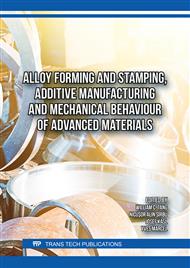[1]
S. Kumar, B. Kishor, Ultrasound Added Additive Manufacturing for Metals and Composites: Process and Control, Chapter First Online (7 August 2021) p.53–72, https://link.springer.com/chapter/
DOI: 10.1007/978-981-16-3184-9_3
Google Scholar
[2]
M.P. Behera, T. Dougherty, S. Singamneni, Conventional and additive manufacturing with metal matrix composites: a perspective, Procedia Manufacturing Volume 30 (2019) pp.159-166
DOI: 10.1016/j.promfg.2019.02.023
Google Scholar
[3]
S. Tilahun, MD Vijayakumar, C R Kannan, S Manivannan, J Vairamuthu, KP Manoj Kumar, A review of ultrasonic welding of various materials and their mechanical properties, IOP Conference Series: Materials Science and Engineering , Volumul 988, International Conference on Recent Developments in Material Science and Applications (ICRDMSA 2020) 25 – 26 septembrie 2020, Chennai, India
DOI: 10.1088/1757-899x/988/1/012113
Google Scholar
[4]
A. Burmak, S. Voloshko, M. Voron, A. Orlov, Influence of ultrasonic impact treatment on structure and properties of 3D-printed metals and alloys, International Samsonov Conference "Materials Science of Refractory Compounds"(27-30 may 2024), https://umrs.org.ua/msrc-2024/abstracts/
DOI: 10.62564/m4-ab1149
Google Scholar
[5]
D. Zhao, D. Ren, K. Zhao, P. Sun, X. Guo, L. Liu, Ultrasonic welding of magnesium–titanium dissimilar metals: a study on thermo-mechanical analyses of welding process by experimentation and finite element method, Chinese J Mech Eng 32 (2019)
DOI: 10.1186/s10033-019-0409-8
Google Scholar
[6]
D. Ren, K. Zhao, M. Pan, Y. Chang, S. Gang, D. Zhao, Ultrasonic spot welding of magnesium alloy to titanium alloy, Scripta Mater 126 (2017) p.58–62
DOI: 10.1016/j.scriptamat.2016.08.003
Google Scholar
[7]
S. Tokita, C.Y. Liu, Y.S. Sato, Effects of material combination for ultrasonic spot welding on microstructure and strength of Al/Al, Al/Cu, and Al/Ni dissimilar joints. Journal of Materials Research and Technology, Volume 26 (2023) pp.1-9570
DOI: 10.1016/j.jmrt.2023.09.094
Google Scholar
[8]
Information on Basic principle of ultrasonic welding, https: // plasticsdecorating.com / articles/2016/the-principles-of-ultrasonic-welding
Google Scholar
[9]
Tescan VEGA LMU scanning optical microscope, provided by ISIM Timisoara, https://eertis.eu/erio-2200-000r-4252
Google Scholar
[10]
Ultrasonic welding machine Vario B 20kHz/4800 (for metallic materials), provided by ISIM Timisoara, https://eertis.eu/erio-2200-000r-4252
Google Scholar
[11]
Information on https://met3dp.ro/produs/a-comprehensive-guide-to-h13-powder
Google Scholar
[12]
Information on http://ro.jxbsc-alloy.com/inconel-alloy-718-uns-n07718w-nr-2-4668-product/.
Google Scholar


